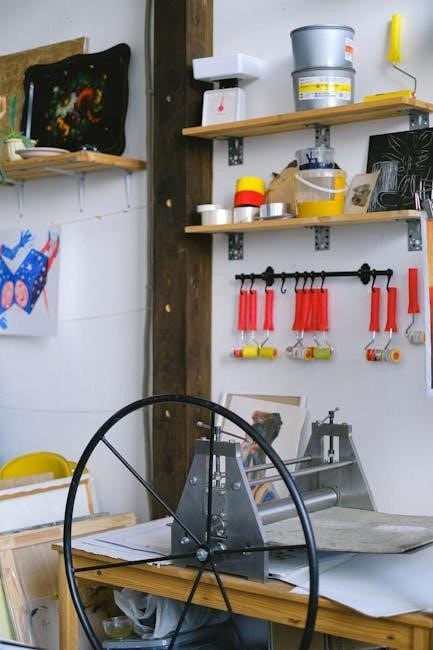A manual hydraulic press is a device that uses a hand-operated pump to generate hydraulic pressure, enabling the application of significant force for pressing, shaping, or compressing materials.
1.1 Definition and Basic Functionality
A manual hydraulic press is a hand-operated device that uses hydraulic pressure to apply force for pressing, shaping, or compressing materials. It operates by transferring force through a hydraulic fluid, enabling precise control and significant pressure application on workpieces.
1.2 Historical Background and Development
The manual hydraulic press traces its origins to the late 19th century, evolving from earlier mechanical presses. Its development was driven by the need for precise force application in industrial and laboratory settings.
Over time, advancements in hydraulic technology led to more efficient designs, making it a versatile tool for metalworking, shaping, and compression tasks across various industries.

Key Components of a Manual Hydraulic Press
The manual hydraulic press consists of a hydraulic cylinder, piston, hand-operated pump, valves, workbench, and mold, all working together to apply controlled force for pressing operations.
2.1 Hydraulic Cylinder and Piston
The hydraulic cylinder and piston are central to the manual press, converting fluid pressure into mechanical force. The cylinder contains the piston, which moves under pressure generated by the pump, transmitting force to the workpiece. This mechanism ensures precise control and amplification of applied pressure, essential for various pressing operations.
2.2 Hand-Operated Pump and Valves
The hand-operated pump generates hydraulic pressure by converting manual effort into fluid force. Valves control the flow and pressure of the hydraulic fluid, enabling precise operation. This system ensures reliable and safe pressure control, allowing users to apply the exact force needed for pressing operations.
2.3 Workbench and Mold
The workbench and mold are essential components of a manual hydraulic press. The workbench provides a stable base for pressing operations, ensuring precision and safety. The mold is used to shape materials under pressure. Its design directly affects the quality and form of the final product. Customizable molds allowing for versatility in various applications.

Working Principle of a Manual Hydraulic Press
A manual hydraulic press operates by converting manual effort into hydraulic pressure, which amplifies force through fluid transfer, enabling precise compression or shaping of materials efficiently.
3.1 Pascal’s Law and Hydraulic Pressure
Pascal’s Law states that pressure applied to a confined fluid is transmitted uniformly in all directions. In a manual hydraulic press, this principle enables the conversion of manual effort into hydraulic pressure, amplifying force through fluid transfer and distributing it evenly across the piston and cylinder, creating the necessary compressive force for pressing operations.
3.2 Role of the Hydraulic System
The hydraulic system in a manual press converts manual effort into hydraulic pressure, enabling the generation of compressive force. It consists of a hand-operated pump, hydraulic cylinder, and valves, ensuring efficient pressure distribution and control. This system allows precise force application, making it versatile for various pressing tasks while maintaining operational consistency and reliability.
3.3 Mechanism of Force Amplification
The manual hydraulic press amplifies force through its hydraulic system, converting manual effort into significant compressive power. By applying pressure via a hand-operated pump, fluid pressure is distributed evenly, enabling the piston to exert a multiplied force on the workpiece. This mechanism leverages hydraulic principles to achieve substantial force amplification, making it highly effective for various pressing operations.

Applications of Manual Hydraulic Press
Manual hydraulic presses are widely used in metal forming, laboratory testing, and industrial manufacturing for pressing, shaping, and compressing materials with precision and control.
4.1 Metal Forming and Shaping
Manual hydraulic presses are essential in metal forming and shaping, offering precise control for tasks like punching, bending, and molding. They apply consistent pressure to achieve desired shapes efficiently, ideal for small-scale operations where accuracy is crucial. Their versatility makes them suitable for various metalworking applications, ensuring high-quality results with minimal effort required by the operator.
4.2 Laboratory and Testing Environments
Manual hydraulic presses are widely used in laboratories for tasks like sample preparation and material testing. They provide controlled pressure for creating uniform samples, such as KBr pellets, and are ideal for precise, low-volume applications. Their compact design and ease of use make them a valuable tool in scientific and research settings, ensuring accurate and reliable results.
4.3 Industrial and Manufacturing Processes
Manual hydraulic presses are essential in various industrial processes for metal forming, assembly, and compression tasks. They offer precise control and high force for shaping materials, making them ideal for manufacturing environments. Their versatility allows for use in both small-scale and large industrial applications, ensuring efficient and reliable performance in producing consistent results.
Safety Guidelines and Precautions
Always ensure the press is on a stable surface, use safety guards, check for leaks or damage, and follow proper training to operate safely and avoid accidents.
5.1 Proper Handling and Maintenance
Regularly inspect hydraulic components for leaks or damage, and lubricate moving parts to ensure smooth operation. Check the pressure system and fluid levels, replacing fluids as needed. Always follow manufacturer guidelines for maintenance and operation to prevent malfunctions and ensure optimal performance over time.
5.2 Safety Guards and Protective Measures
Always use safety guards to prevent accidental contact with moving parts. Ensure the workpiece is securely positioned to avoid ejection during pressing. Wear protective gear, such as gloves and safety glasses, to safeguard against potential hazards. Never bypass safety mechanisms, and keep loose clothing tied back to prevent entanglement.
5.3 Emergency Procedures and Troubleshooting
In case of emergencies, immediately release hydraulic pressure using the emergency valve. Check for fluid leaks or malfunctioning parts. If the press stalls, ensure proper alignment and recheck the hydraulic system. Regularly inspect hoses and connections for wear. Lubricate moving parts to prevent friction-related issues. Address any unusual noises promptly to avoid further damage.
Step-by-Step Guide to Using a Manual Hydraulic Press
Raise the safety guard, place the work centrally, lower the guard, and operate the hand pump to apply pressure gradually. Ensure proper alignment and slowly press.
6.1 Preparation and Setup
Begin by inspecting the press for any damage or wear. Raise the safety guard and ensure the workbench is clear. Position the material centrally on the lower bolster, aligning it properly. Secure any necessary molds or dies. Lower the safety guard to ensure safe operation and prevent accidents during pressing. Always follow safety protocols.
6.2 Operating the Press
Begin by pumping the handle to generate hydraulic pressure. As the piston advances, it applies force to the workpiece. Use slow, controlled strokes to ensure even pressure distribution. Monitor the pressure gauge and adjust as needed. Maintain steady operation to achieve precise results. Always keep hands away from moving parts to ensure safety during the pressing process.
6.3 Post-Operation Procedures
After completing the pressing task, release the hydraulic pressure gradually. Lower the piston slowly and remove the workpiece. Clean the press and work area, ensuring all surfaces are clear of debris. Power down the machine and secure any loose components. Inspect for wear or leaks. Record the operation details for maintenance tracking. Prepare the press for storage or next use.
Comparison with Other Types of Presses
A manual hydraulic press differs from automatic presses by relying on hand operation, offering portability and lower costs. Unlike arbor presses, it provides higher pressure for heavier tasks.
7.1 Manual vs. Automatic Hydraulic Press
A manual hydraulic press relies on a hand-operated pump for pressure generation, offering portability and cost-effectiveness for small-scale tasks. In contrast, an automatic hydraulic press uses motorized pumps, enabling faster and more efficient operation for large-scale industrial applications, though at a higher cost and complexity.
7.2 Hydraulic Press vs. Arbor Press
A hydraulic press uses fluid pressure to generate force, offering high pressure but slower operation, while an arbor press relies on a lever or gear system for mechanical advantage, providing faster and more precise control for smaller-scale tasks. Both are used for pressing operations but differ in mechanism, speed, and suitability for specific applications.
Selecting the Right Manual Hydraulic Press
Selecting the right manual hydraulic press involves considering tonnage and capacity needs, as presses are available in 15-ton, 25-ton, and lower configurations like 0-5, 0-2, and 0-1 tons.
8.1 Considering Tonnage and Capacity
When choosing a manual hydraulic press, selecting the appropriate tonnage and capacity is crucial. Common configurations include 15-ton and 25-ton presses, with lower options like 0-5, 0-2, and 0-1 tons available for specific tasks. Matching the press capacity to the workload ensures efficiency and safety, preventing damage to the equipment and material.
8.2 Evaluating Features and Accessories
Evaluating features and accessories is essential for optimizing the manual hydraulic press’s performance. Key considerations include pressure control systems for precise force application, customizable mold designs for specific tasks, and safety features like guards and ergonomic handles. Additional accessories, such as digital pressure gauges or quick-release mechanisms, can enhance functionality and user experience, ensuring the press meets operational demands effectively.

Maintenance and Repair Tips
Regular lubrication of moving parts and inspection of seals and pistons are crucial. Replace worn components promptly and check hydraulic fluid levels to ensure optimal performance.
9.1 Regular Lubrication and Inspection
Regular lubrication of all moving parts ensures smooth operation and prevents wear. Inspect the hydraulic system, piston, and cylinder surfaces for damage or leaks. Check hydraulic fluid levels and condition, replacing it if degraded. Clean or replace filters to maintain efficiency. Schedule periodic inspections to identify and address potential issues before they escalate, ensuring optimal performance and longevity of the press.
9.2 Replacing Wearable Parts
Identify and replace worn parts, such as seals, O-rings, and piston rings, to prevent hydraulic fluid leaks and maintain system efficiency. Check the hydraulic cylinder and piston for wear. Use genuine replacement parts to ensure compatibility and performance. Regularly replace the hydraulic fluid filter to prevent contamination. Always follow manufacturer guidelines for replacement procedures to avoid damage and ensure optimal functionality.
Advanced Features and Customization
Manual hydraulic presses offer advanced features like pressure control systems and customizable mold designs, enhancing functionality for specific tasks and improving efficiency in various operations.
10.1 Pressure Control Systems
Pressure control systems in manual hydraulic presses allow precise regulation of applied force, ensuring consistent and accurate results. These systems often feature adjustable valves and gauges, enabling users to set specific pressure levels for different tasks. This customization enhances the versatility of the press, making it suitable for a wide range of applications requiring varying degrees of force.
10.2 Customizable Mold Designs
Customizable mold designs for manual hydraulic presses enable users to tailor the pressing process to specific materials or applications. These molds can be adapted for various shapes, sizes, and project requirements, ensuring precise results. Interchangeable molds enhance versatility, allowing the press to be used across different industries, from metalworking to laboratory settings, for consistent and efficient outcomes.

Environmental and Cost Considerations
Manual hydraulic presses offer energy efficiency and cost-effectiveness, making them environmentally friendly and economical for various industrial applications.
11.1 Energy Efficiency
Manual hydraulic presses are energy-efficient, relying on manual operation to generate pressure, reducing reliance on external power sources. They convert manual effort into hydraulic pressure efficiently, minimizing energy consumption. This makes them suitable for applications where electricity is limited or conservation is prioritized, offering a sustainable option for pressing tasks in various industries.
11.2 Cost-Effectiveness
Manual hydraulic presses are cost-effective solutions for various industries due to their low operational costs and durability. They eliminate the need for electricity, reducing energy expenses and offering a budget-friendly alternative for small-scale operations. Their robust construction minimizes maintenance needs, making them a financially sustainable choice for applications requiring consistent pressing or shaping tasks without high overhead costs.

Case Studies and Real-World Applications
Manual hydraulic presses are widely used in laboratories for pellet pressing and in manufacturing for metal forming. Real-world applications include KBr pellet production and industrial metal shaping tasks.
12.1 Industrial Case Studies
Manual hydraulic presses are integral in industrial metal forming, stamping, and assembly processes. They are used for precise force application in manufacturing automotive parts, aerospace components, and machinery. Their compact design and controlled pressure make them ideal for producing KBr pellets and shaping metal sheets efficiently in production lines, ensuring consistency and quality in industrial workflows.
12.2 Laboratory Case Studies
Manual hydraulic presses are essential in laboratory settings for tasks requiring precise pressure control. They are widely used for producing KBr pellets in spectroscopy. Their controlled force application ensures consistent sample preparation, making them indispensable in analytical laboratories for various material testing and research applications, particularly in pharmaceutical and chemical industries.
Future Trends and Innovations
Future trends include integration with automation, smart sensors, and IoT connectivity for enhanced efficiency. Sustainable practices and eco-friendly materials are also being explored to reduce environmental impact.
13.1 Integration with Automation
Manual hydraulic presses are increasingly being integrated with automated systems, such as smart sensors and IoT connectivity, to enhance operational efficiency. Automation enables real-time monitoring, precise control, and data-driven decision-making, reducing manual intervention. This integration aligns with Industry 4.0 trends, offering improved consistency, safety, and productivity. It also allows for seamless integration into smart manufacturing workflows, ensuring optimal performance in modern industrial environments.
13.2 Sustainable Practices
Manual hydraulic presses are being adapted to align with sustainable practices, focusing on energy efficiency and reduced environmental impact. Eco-friendly hydraulic fluids and optimized energy use minimize ecological footprints. Additionally, manufacturers are incorporating recyclable materials and designing presses for longevity, reducing waste. These practices not only benefit the environment but also enhance operational efficiency and cost-effectiveness for industries adopting sustainable solutions.
The manual hydraulic press is a versatile, efficient tool with wide-ranging applications, offering precise control and cost-effectiveness. Its enduring relevance ensures continued use in various industries.
14.1 Summary of Key Points
A manual hydraulic press efficiently applies force using hydraulic pressure, ideal for metal forming, lab testing, and industrial tasks. Its compact design, ease of operation, and cost-effectiveness make it a reliable tool for precise compression and shaping, ensuring consistent results across various applications while maintaining energy efficiency and safety standards.
14.2 Final Thoughts
Manual hydraulic presses offer a reliable, efficient, and versatile solution for various industrial and laboratory tasks. Their ability to apply precise force with minimal effort makes them indispensable tools. With proper maintenance and safety precautions, these presses continue to provide consistent performance, making them a valuable investment for both small-scale and large-scale operations.
